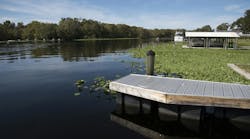About the author: Lambert is a storm water consultant at CONTECH Stormwater Solutions. He can be reached at 503/749-4242 or by e-mail at [email protected].
Kachemak Bay is the recreational hub for the 4,000 residents of Homer, Alaska, and the many tourists who travel there every year. The bay boasts some of the richest marine invertebrate environments in Alaska’s Cook Inlet. A feeding ground and habitat for sea ducks, shorebirds, small mammals and fish, the bay is popular with commercial and recreational fishermen.
Over the years, the Alaska Department of Environmental Conservation, the city of Homer, the Alaska Department of Transportation (DOT) and environmental groups have seen a growing potential for contamination in the bay. The area gets about 26 in. of rain and snow each year, most of which falls between September and February. The town often gets intense rainfall during the summer as well. These storms create runoff over the town’s roads and through culverts carrying pollutants like oil, grease and debris toward the bay. The town and state knew that preventive steps would have to be taken to reduce the effect of polluted storm water on the bay and its plentiful marine life.
As part of state-funded road reconstruction to Pioneer, Bartlett and Hohe streets, the Alaska Department of Environmental Conservation, the DOT and the town chose a best management practice (BMP) solution for removing road oil and other pollutants from storm water runoff. Two major streets, Bartlett Street and Pioneer Avenue, intersect just north of Sterling Highway, which skirts the edge of the town. Hohe Street runs parallel to the north end of Bartlett and is about a quarter mile long.
The hospital parking lot at the top of Bartlett also could be a contributing source of polluted runoff. The half-mile path from the hospital parking lot down the street is a declining, rolling grade with a slope varying between 9 and 5%.
The road improvement project offered a chance to protect the bay by treating runoff to state standards before discharging it into a ditch system that goes under Sterling Highway and eventually into the bay. The BMP chosen was a CONTECH Stormwater Management StormFilter, the first used in Alaska.
“Pre-treating runoff is new for Alaska,” said Jason Baxley, project manager for the Alaska DOT on this effort. “But we’re doing more projects like this one.”
Now runoff goes into the StormFilter, a system based on passive, siphon-actuated, media-filled filter cartridges that trap and absorb particulates, hydrocarbons and other pollutants before discharging treated rainwater or melted snow. The 8- x 18-ft vault holds 32 cartridges filled with ZPG media composed of zeolite, perlite and granular-activated carbon. Each cartridge has a flow rate of 15 gpm for a total treated first flow of 1.056 cu ft per second.
The reinforced precast concrete vault was built locally and buttressed with cross walls to withstand heavier vehicular traffic.
According to Baxley, Alaska does not require reinforcement for earthquakes for storm water systems.
Baxley said the original StormFilter design placed it in the intersection of Pioneer Avenue and Bartlett, but to get the needed depth to cover it properly, they moved the system about 50 ft up the base of Bartlett Street. The contractor, Zubeck Inc., placed the vault in Bartlett Street.
The underground StormFilter was easy to install, according to Brad Zubeck, vice president of Zubeck. He said the only challenge during construction was maneuvering the crane around nearby power lines. But placing the system meant closing the street, so the work was done over a weekend.
“It took us about a day to excavate and install the system about 31⁄2 ft under ground using a crane,” Zubeck said. The second day, the contractor backfilled and finished the vault site.
Baxley said Alaska and its cities often share road maintenance, including snowplowing in the winter. Because the mixed ownership is often confusing, the state is trying to return maintenance to its cities when it can. As a part of the agreement for this roadwork, Alaska turned the maintenance responsibilities for Bartlett and Pioneer, as well as the StormFilter system, over to the town.
The cartridges in the filtration system are effective for 12 to 24 months, depending on the rainfall and the runoff pollutant load. Using the three manholes for easy access, maintenance workers can easily dismount and change the spent cartridges, then shovel out the dirt and grime, or it can be removed using a vacuum truck.
By working together, both the state and the city were able to help reduce the impact of the road runoff on Kachemak Bay and its rocky shores.
Today, runoff flows down Bartlett and Hohe streets into a conveyance system that leads to the StormFilter. The StormFilter traps significant oil, solids and pollutants. The clean runoff eventually passes under the Sterling Highway and into wetlands before it reaches the bay.

